Working With A New Tilt/Shift Lens
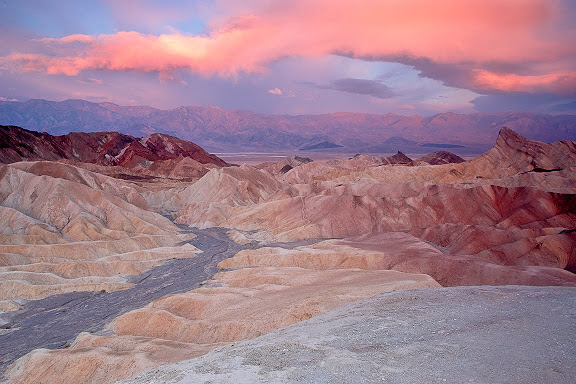
I begin each of my workshops in Death Valley National Park by saying that we're standing in the lowest, hottest, driest and windiest place on the planet," says veteran outdoor photographer Steve Kossack. "I then add, 'on most days.' Our visit this year to Death Valley followed a far-from-ordinary winter in California, so we weren't too surprised to be greeted this spring by some rather hostile weather. In a short one-week span in mid-April, the temperatures fell from almost 100 degrees F to the mid 20's, and then headed back to the century mark again as we departed. Snow fell at daybreak, wind and rain tried to chase us off ridges, but colorful sunsets and a break from the really hot weather made for some great shooting days as well. From elevations of almost 300 feet below sea level to more than 6,000 feet above, this magical landscape gave us more to experience and photograph than we could have imagined.
The image above of Zabriskie Point was captured at my favorite sunrise location, bar none. This image is also noteworthy as one of the first taken with my new Canon 24mm Tilt/Shift Lens Mark ll, which, as its name indicates, is one of Canon's newest tilt-shift lenses. Now that I've seen the greatly improved optical performance of this lens, I'm tempted to shoot every frame with it from now until forever! It is just that good. For this image, I wanted to raise 'the platform' we were shooting from. Since the Mark ll allows tilt and shift movements in any direction, I simply made the lens tilt downward along the same vertical axis as the upward shift of the lens. This accentuated the sand-colored shelf on which my tripod was set up, making it look more like a cliff instead of a small hill. The stage was now set for the magnificent sunrise we witnessed. All that was needed, as the intensity of the light increased, was the use of a Singh-Ray 3-stop soft-step ND Grad and then, as the direct light made its way to the Panamint Mountain range across the valley floor, I switched to a 4-stop soft-step ND Grad for this frame.
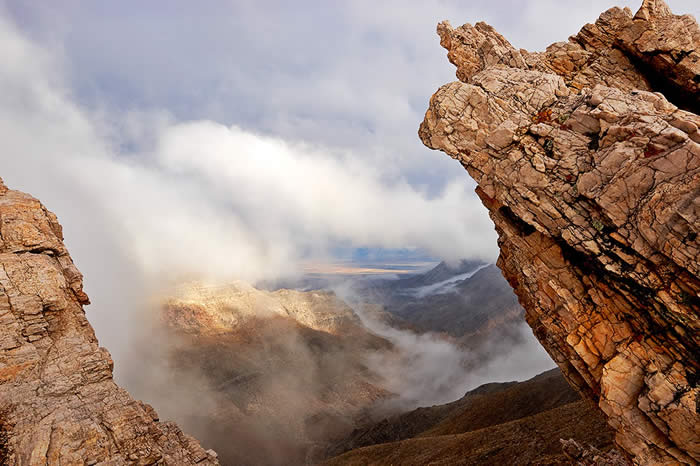
This next image was taken at Aquereberry Point 0as the morning snow dissipated. Yes, snow in April in Death Valley. We witnessed no more than a few seconds of partial clearing. Setting up a shot I made many times before gave me the freedom to watch and wait. It paid off big after making the movements of the T/S to straighten the vertical lines of the foreground rocks while holding the depth of field at near infinity. Knowing that I would need the quickest shutter setting possible to stop the motion of the moving clouds -- thinking that a slower shutter speed would render fast moving clouds a gray mess -- I then raised my ISO to 800 and again waited. In the moments of clearing and light that followed, I was able to make only 3 frames at a wide open f/3.5 as I inserted a 3-stop hard-step ND Grad horizontally across the lens. At this point, I had to stop and watch the last few seconds before the entire scene disappeared. It was all simply breath taking!
It's been many years since I added anything to my basic photo gear. As I get older, I think more like a backpacker than a pack mule! These days, I'm more inclined to use the smaller lighter pack, with the zoom lenses, rather than the much bigger and heavier one that contains the fixed-focal-length lenses. I've long traveled with both packs and usually make a decision according to how far and how long when I depart the vehicle or campground. Today two zooms and an extender will usually suffice, with one exception. My tilt/shift lenses go with me no matter which pack I choose.
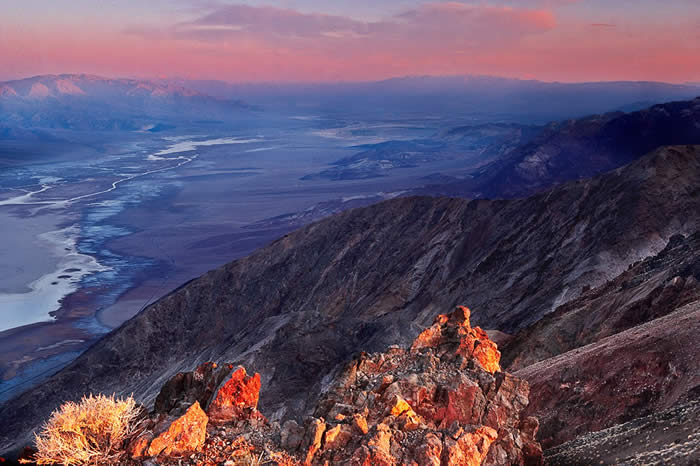
This sunrise image of the southern basin of Death Valley was captured at Dante's View. After several previous attempts to get a break in the weather, we finally got one. In the pre-dawn light, we could see more than a mile down -- from over 6,000 feet above sea level dropping to almost 300 feet below sea level on the floor of the basin. We stood awaiting the sunrise. Since the wind was sporadic, I began making frames in between gusts but quickly changed my setup to include mostly rock so as not to be concerned with moving objects. After working many frames with the Singh-Ray Color Intensifier, I switched to the ColorCombo at first light to reduce the glare and haze. As the bright sunlight muted the color in the clouds, I then ran through my ND Grad filters starting with a 2-stop soft-step and working my way up to a 4-stop hard-step. The frame shown was captured with the ColorCombo and 3-stop hard-step.
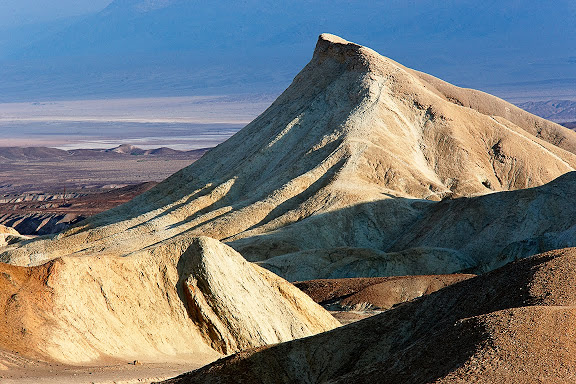
No place in Death Valley reveals more clearly the hand of man than Twenty Mule Team Canyon. This is where the Borax company had their first operation and where the teams of mules set out on their 120-mile trip to deliver the goods to the railhead. If you stand still in the morning light on the ridges of this now quiet setting, I think you might imagine the sound and struggle that took place here some 100 years ago. For me, this is long-lens country. In the cross light here, there seem to be many compositions that work no matter what the weather or light situation! Here all that was needed was to pick some lines that went dark-to-light-to-dark, then dropping my modified Singh-Ray ColorCombo into the filter drawer of the Canon 300mm 2.8 IS and adjusting the filter's built-in polarizer to cut the glare of the brightly lit rock. I metered for the mid tones. It's a rare day when, using this lens, I don't want the ColorCombo. I have a bad habit of leaving it in the lens. If I can't find it when working with the 500mm, I know it's still in the 300mm, or vice versa, but I rarely have both with me in the field. Having a filter to leave in each lens would be the ideal solution!
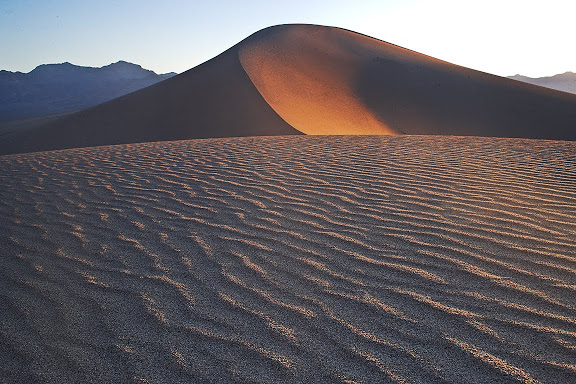
As much as I enjoy photographing in the Dunes, I find it difficult to come up with images I consider unique and creative. Maybe that's why I've tried long and hard, with varying degrees of success, and so many drastically different compositions! Angle of view and degree of light are the keys. Exposure even more so. To get the highlights glistening off the early morning sand patterns is difficult to say the least. Careful metering gives way to best guess -- as the intensity of the light increases with each second after sunrise. Choosing where to meter for this frame brought both the highlights of the foreground sand and the sweep of the huge dune into usable zones. Just before actual sunrise and direct light, I attached the ColorCombo knowing that I would have to visually check the orientation to make sure I did not cut the highlights from the foreground. With the direct light, the next step was choosing a 4-stop soft-step ND grad to hold as much of the bright blue sky light as possible. This frame is simply all about the exposure and the filters used to get it.
Death Valley is the place that initially drove me to learn the art of landscape photography those many years ago. It's a place where I return to remember this fact, to learn more, and to enjoy the beauty of nature."
Client Comments
"I been spending some time lately thinking about what what really brings joy into my life. Outdoor photography and all that it encompasses is a very very large part of that In my quiet moments I go to those special places in my mind and remember the feelings I was trying to capture with my camera. I appreciate you introducing me to that world. Our first trip was to Yosemite in the winter. I appreciated you and Tim being so patent with me as I knew very little about photography. It has grown from there. I appreciate the fundamentals you have taught me. It is the best way to do things. The thing I most appreciate is your passion for nature and struggle for survival and beautiful things and beautiful places. For me it was contagious and has added a whole new dimension to my life. You gave me a gift that was unique to you. Steve, I want to thank you for that."
